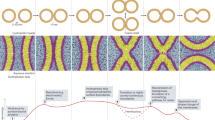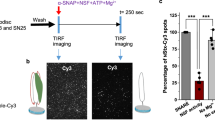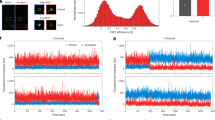Abstract
Formation of the soluble N-ethylmaleimide-sensitive factor attachment protein receptor (SNARE) complex facilitates intracellular membrane fusion. A single SNARE complex is thought to be insufficient; multiple copies of SNARE complexes must work cooperatively. However, the mechanism by which such a higher-order SNARE protein structure is assembled is unknown. EPR and fluorescence analyses show that at least three copies of target-membrane SNARE proteins self-assemble through the interaction between the transmembrane domains (TMDs), and this multimeric structure serves as scaffolding for trans-SNARE assembly. SNARE core formation in solution induces oligomerization of the TMDs of vesicle-associated SNAREs in the apposing membrane, transiently forming a supramolecular protein structure spanning two membranes. This higher-order protein intermediate evolves, by involving lipid molecules, to the hemifusion state. Hemifusion is subsequently followed by distal leaflet mixing and formation of the cis-SNARE complex.
This is a preview of subscription content, access via your institution
Access options
Subscribe to this journal
Receive 12 print issues and online access
$259.00 per year
only $21.58 per issue
Buy this article
- Purchase on SpringerLink
- Instant access to full article PDF
Prices may be subject to local taxes which are calculated during checkout





Similar content being viewed by others
References
Ungar, D. & Hughson, F.M. SNARE protein structure and function. Annu. Rev. Cell Dev. Biol. 19, 493–517 (2003).
Brunger, A.T. Structural insights into the molecular mechanism of calcium-dependent vesicle–membrane fusion. Curr. Opin. Struct. Biol. 11, 163–173 (2001).
Jahn, R., Lang, T. & Sudhof, T.C. Membrane fusion. Cell 112, 519–533 (2003).
Rothman, J.E. Mechanisms of intracellular protein transport. Nature 372, 55–63 (1994).
Poirier, M.A. et al. The synaptic SNARE complex is a parallel four-stranded helical bundle. Nat. Struct. Biol. 5, 765–769 (1998).
Sutton, R.B., Fasshauer, D., Jahn, R. & Brunger, A.T. Crystal structure of a SNARE complex involved in synaptic exocytosis at 2.4 Å resolution. Nature 395, 347–353 (1998).
Hanson, P.I., Roth, R., Morisaki, H., Jahn, R. & Heuser, J.E. Structure and conformational changes in NSF and its membrane receptor complexes visualized by quick-freeze/deep-etch electron microscopy. Cell 90, 523–535 (1997).
Lin, R.C. & Scheller, R.H. Structural organization of the synaptic exocytosis core complex. Neuron 19, 1087–1094 (1997).
Katz, L., Hanson, P.I., Heuser, J.E. & Brennwald, P. Genetic and morphological analyses reveal a critical interaction between the C-termini of two SNARE proteins and a parallel four helical arrangement for the exocytic SNARE complex. EMBO J. 17, 6200–6209 (1998).
Antonin, W., Fasshauer, D., Becker, S., Jahn, R. & Schneider, T.R. Crystal structure of the endosomal SNARE complex reveals common structural principles of all SNAREs. Nat. Struct. Biol. 9, 107–111 (2002).
Strop, P., Kaiser, S.E., Vrljic, M. & Brunger, A.T. The structure of the yeast plasma membrane SNARE complex reveals destabilizing water filled cavities. J Biol. Chem. 283, 1113–1119 (2008).
Hua, Y. & Scheller, R.H. Three SNARE complexes cooperate to mediate membrane fusion. Proc. Natl. Acad. Sci. USA 98, 8065–8070 (2001).
Otto, H., Hanson, P.I. & Jahn, R. Assembly and disassembly of a ternary complex of synaptobrevin, syntaxin, and SNAP-25 in the membrane of synaptic vesicles. Proc. Natl. Acad. Sci. USA 94, 6197–6201 (1997).
Rickman, C., Hu, K., Carroll, J. & Davletov, B. Self-assembly of SNARE fusion proteins into star-shaped oligomers. Biochem. J. 388, 75–79 (2005).
Hayashi, T. et al. Synaptic vesicle membrane fusion complex: action of clostridial neurotoxins on assembly. EMBO J. 13, 5051–5061 (1994).
Chen, Y.A., Scales, S.J., Patel, S.M., Doung, Y.C. & Scheller, R.H. SNARE complex formation is triggered by Ca2+ and drives membrane fusion. Cell 97, 165–174 (1999).
Chernomordik, L.V. & Kozlov, M.M. Protein-lipid interplay in fusion and fission of biological membranes. Annu. Rev. Biochem. 72, 175–207 (2003).
Langosch, D., Hofmann, M. & Ungermann, C. The role of transmembrane domains in membrane fusion. Cell. Mol. Life Sci. 64, 850–864 (2007).
Bowen, M.E., Engelman, D.M. & Brunger, A.T. Mutational analysis of synaptobrevin transmembrane domain oligomerization. Biochemistry 41, 15861–15866 (2002).
Laage, R., Rohde, J., Brosig, B. & Langosch, D. A conserved membrane-spanning amino acid motif drives homomeric and supports heteromeric assembly of presynaptic SNARE proteins. J. Biol. Chem. 275, 17481–17487 (2000).
Han, X., Wang, C.T., Bai, J., Chapman, E.R. & Jackson, M.B. Transmembrane segments of syntaxin line the fusion pore of Ca2+-triggered exocytosis. Science 304, 289–292 (2004).
Margittai, M., Otto, H. & Jahn, R. A stable interaction between syntaxin 1a and synaptobrevin 2 mediated by their transmembrane domains. FEBS Lett. 446, 40–44 (1999).
Chow, R.H., von Ruden, L. & Neher, E. Delay in vesicle fusion revealed by electrochemical monitoring of single secretory events in adrenal chromaffin cells. Nature 356, 60–63 (1992).
Wang, P., Wang, C.T., Bai, J., Jackson, M.B. & Chapman, E.R. Mutations in the effector binding loops in the C2A and C2B domains of synaptotagmin I disrupt exocytosis in a nonadditive manner. J. Biol. Chem. 278, 47030–47037 (2003).
Yoon, T.Y., Okumus, B., Zhang, F., Shin, Y.K. & Ha, T. Multiple intermediates in SNARE-induced membrane fusion. Proc. Natl. Acad. Sci. USA 103, 19731–19736 (2006).
Abdulreda, M.H., Bhalla, A., Chapman, E.R. & Moy, V.T. Atomic force microscope spectroscopy reveals a hemifusion intermediate during soluble N-ethylmaleimide-sensitive factor-attachment protein receptors-mediated membrane fusion. Biophys. J. 94, 648–655 (2008).
Liu, T., Wang, T., Chapman, E. & Weisshaar, J. Productive hemifusion intermediates in fast vesicle fusion driven by neuronal SNAREs. Biophys. J. 94, 1303–1314 (2008).
Xu, Y., Zhang, F., Su, Z., McNew, J.A. & Shin, Y.K. Hemifusion in SNARE-mediated membrane fusion. Nat. Struct. Mol. Biol. 12, 417–422 (2005).
Lu, X., Zhang, F., McNew, J.A. & Shin, Y.K. Membrane fusion induced by neuronal SNAREs transits through hemifusion. J. Biol. Chem. 280, 30538–30541 (2005).
Reese, C., Heise, F. & Mayer, A. Trans-SNARE pairing can precede a hemifusion intermediate in intracellular membrane fusion. Nature 436, 410–414 (2005).
Wong, J.L., Koppel, D.E., Cowan, A.E. & Wessel, G.M. Membrane hemifusion is a stable intermediate of exocytosis. Dev. Cell 12, 653–659 (2007).
Hofmann, M.W. et al. Self-interaction of a SNARE transmembrane domain promotes the hemifusion-to-fusion transition. J. Mol. Biol. 364, 1048–1060 (2006).
Giraudo, C.G. et al. SNAREs can promote complete fusion and hemifusion as alternative outcomes. J. Cell Biol. 170, 249–260 (2005).
Zampighi, G.A. et al. Conical electron tomography of a chemical synapse: vesicles docked to the active zone are hemi-fused. Biophys. J. 91, 2910–2918 (2006).
Monck, J.R. & Fernandez, J.M. The exocytotic fusion pore and neurotransmitter release. Neuron 12, 707–716 (1994).
Mayer, A. What drives membrane fusion in eukaryotes? Trends Biochem. Sci. 26, 717–723 (2001).
Jackson, M.B. & Chapman, E.R. Fusion pores and fusion machines in Ca2+-triggered exocytosis. Annu. Rev. Biophys. Biomol. Struct. 35, 135–160 (2006).
Lindau, M. & Almers, W. Structure and function of fusion pores in exocytosis and ectoplasmic membrane fusion. Curr. Opin. Cell Biol. 7, 509–517 (1995).
Jackson, M.B. In search of the fusion pore of exocytosis. Biophys. Chem. 126, 201–208 (2007).
Zhang, Y. & Shin, Y.K. Transmembrane organization of yeast syntaxin-analogue Sso1p. Biochemistry 45, 4173–4181 (2006).
Meers, P., Ali, S., Erukulla, R. & Janoff, A.S. Novel inner monolayer fusion assays reveal differential monolayer mixing associated with cation-dependent membrane fusion. Biochim. Biophys. Acta 1467, 227–243 (2000).
Li, F. et al. Energetics and dynamics of SNAREpin folding across lipid bilayers. Nat. Struct. Mol. Biol. 14, 890–896 (2007).
Tokumaru, H. et al. SNARE complex oligomerization by synaphin/complexin is essential for synaptic vesicle exocytosis. Cell 104, 421–432 (2001).
Yersin, A. et al. Interactions between synaptic vesicle fusion proteins explored by atomic force microscopy. Proc. Natl. Acad. Sci. USA 100, 8736–8741 (2003).
Nazarov, P.V., Koehorst, R.B., Vos, W.L., Apanasovich, V.V. & Hemminga, M.A. FRET study of membrane proteins: determination of the tilt and orientation of the N-terminal domain of M13 major coat protein. Biophys. J. 92, 1296–1305 (2007).
Zhuang, X. et al. Fluorescence quenching: a tool for single-molecule protein-folding study. Proc. Natl. Acad. Sci. USA 97, 14241–14244 (2000).
Ha, T. & Xu, J. Photodestruction intermediates probed by an adjacent reporter molecule. Phys. Rev. Lett. 90, 223002 (2003).
Chen, Y., Xu, Y., Zhang, F. & Shin, Y.K. Constitutive versus regulated SNARE assembly: a structural basis. EMBO J. 23, 681–689 (2004).
Acknowledgements
Support for this work was provided by the US National Institutes of Health.
Author information
Authors and Affiliations
Contributions
X.L. performed the fluorescence assay; Y.Z. performed the EPR analysis. Y.-K.S. designed the experiment and wrote the paper.
Corresponding author
Supplementary information
Supplementary Text and Figures
Supplementary Figures 1–2 and Supplementary Table 1 (PDF 124 kb)
Rights and permissions
About this article
Cite this article
Lu, X., Zhang, Y. & Shin, YK. Supramolecular SNARE assembly precedes hemifusion in SNARE-mediated membrane fusion. Nat Struct Mol Biol 15, 700–706 (2008). https://doi.org/10.1038/nsmb.1433
Received:
Accepted:
Published:
Issue date:
DOI: https://doi.org/10.1038/nsmb.1433
This article is cited by
-
The blockade of the neurotransmitter release apparatus by botulinum neurotoxins
Cellular and Molecular Life Sciences (2014)
-
A Hypothetical Model of Cargo-Selective Rab Recruitment During Organelle Maturation
Cell Biochemistry and Biophysics (2012)
-
The SM protein Vps33 and the t-SNARE Habc domain promote fusion pore opening
Nature Structural & Molecular Biology (2010)



